
Aitken is a large lunar impact crater that lies on the far side of the Moon, named for Robert Grant Aitken, an American astronomer specializing in binary stellar systems. It is located to the southeast of the crater Heaviside, and north of the unusual formation Van de Graaff. Attached to the southwest rim is Vertregt. To the southeast is the smaller Bergstrand.

Cavalerius is a prominent lunar impact crater that lies on the western edge of the Oceanus Procellarum lunar mare on the west part of the visible Moon. It nearly joins the northern rim of Hevelius to the south.

Biela is a lunar impact crater that is located in the rugged highlands of the southeastern Moon. It is named after Austrian astronomer Wilhelm von Biela. The crater lies to the east of Rosenberger, to the southeast of the Watt–Steinheil double crater.

Casatus is a lunar impact crater that is located near the southern limb of the Moon. The north-northeast rim of the crater overlies a portion of the slightly larger crater Klaproth. Along the western rim, Casatus A intrudes somewhat into the interior, producing an inward-bowing rim. To the southeast of Casatus is Newton.
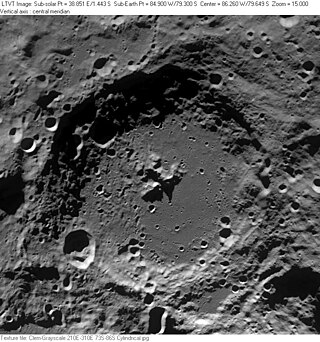
Drygalski is a large lunar impact crater that lies along the southern limb of the Moon. It partly overlies the crater Ashbrook to the west on the far side of the Moon. Just to the north of Drygalski is the smaller Boltzmann. The location of this crater restricts its observation from the Earth, and even under conditions of favorable libration it is viewed from the edge. It is only illuminated by the Sun at an oblique angle, and it lies close to the south polar craters that are permanently shielded from sunlight.

Campbell is a large lunar impact crater that is located in the northern hemisphere on the far side of the Moon. It lies to the southwest of the walled plain D'Alembert, an even larger formation. If Campbell were located on the near side of the Moon as seen from the Earth, it would form one of the largest visible craters, being slightly larger than Schickard. It is bordered by several craters of note, with Wiener to the southwest, Von Neumann just to the south, Ley overlying the southeast rim, and Pawsey to the west.

Chapman is a lunar impact crater that lies just beyond the northwest rim of the Moon, on the far side as seen from the Earth. It lies to the northeast of the crater Rynin, and southward of the large walled plain Poczobutt.

Dyson is a lunar impact crater, 63 kilometers in diameter, that lies on the far side of the Moon, past the northwest limb. It is located in the northern part of the surface, to the northwest of the crater Coulomb, and east of van't Hoff.

Ricco is a lunar impact crater. It is located in the northern part of the Moon's far side. This crater overlies the southeastern rim of the larger crater Milankovic. Less than one crater diameter to the southwest is Karpinskiy, while to the southeast is Roberts.
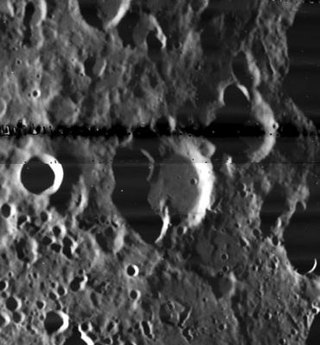
Douglass is a lunar impact crater on the far side of the Moon. It lies to the southwest of the crater Frost and south-southwest of the large walled plain Landau.

Donner is a lunar impact crater on the far side of the Moon. It is located just to the northeast of the Mare Australe, behind the southeastern limb of the Moon. During favorable librations this part of the lunar surface can be brought into view of the Earth, but the site is viewed from the edge and so not much detail can be seen.

Espin is a lunar impact crater that lies on the far side of the Moon, just beyond the northeastern limb. It lies to the west-southwest of the larger crater Seyfert, and northwest of Deutsch.

Fowler is a large lunar impact crater that lies in the northern hemisphere on the Moon's far side. It lies to the south-southwest of the crater Esnault-Pelterie, and north of Gadomski. Overlying the eastern rim and intruding into the interior is Von Zeipel.

Harriot is a lunar impact crater that is located on the far side of the Moon from the Earth. It lies just to the north of the much larger crater Seyfert. To the northeast of Harriot is the crater Cantor. About one and a half crater diameters to the north of Harriot is the eastern end of a crater chain named Catena Sumner. This feature continues to the west-northwest for a distance of 247 km, passing to the north of the crater Sumner.

Gullstrand is a lunar impact crater that lies on the northern hemisphere on the Moon's far side. About one crater diameter to the southeast is the larger crater Perrine. To the west-southwest is Quetelet.

Kibalʹchich is a crater on the Moon's far side. It lies to the northeast of the large walled plain Korolev, and is attached to the southeastern outer rim of the crater Tsander.
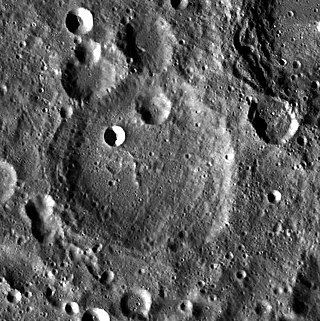
Kurchatov is a lunar impact crater that is located on the Moon's far side. It is just to the southwest of the crater Wiener, and farther to the southeast of Bridgman. A couple of crater diameters to the south of Kurchatov is the northern edge of the Mare Moscoviense.

Laue is a lunar impact crater that lies across the south-southwestern rim and interior floor of the huge walled plain Lorentz. This feature is located on the Moon's far side, just beyond the west-northwestern limb. Under conditions of favorable libration and illumination from the Sun, this area can be seen at a very oblique angle from the Earth.
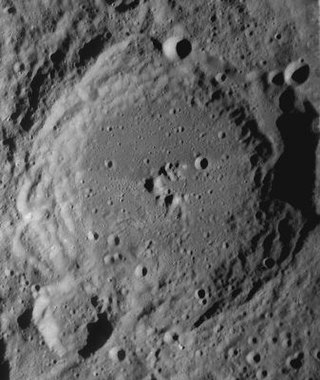
Wiener is a lunar impact crater that lies on the Moon's far side. It is located just to the southwest of the larger crater Campbell. To the southwest of Wiener is the heavily worn Kurchatov. To the east along the rim of Campbell is Von Neumann. The smaller crater Pawsey lies to the north-northwest, and is partly overlain by the outer rampart of Wiener.
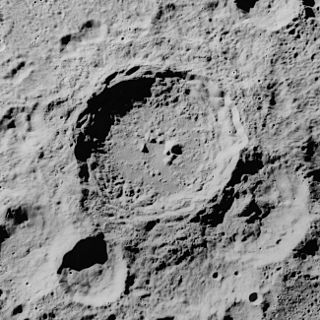
Olcott is a relatively fresh crater on the far side of the Moon. It was named after American astronomer William Tyler Olcott. It lies to the south-southeast of the craters Seyfert and Polzunov, and to the north of Kostinskiy.






















